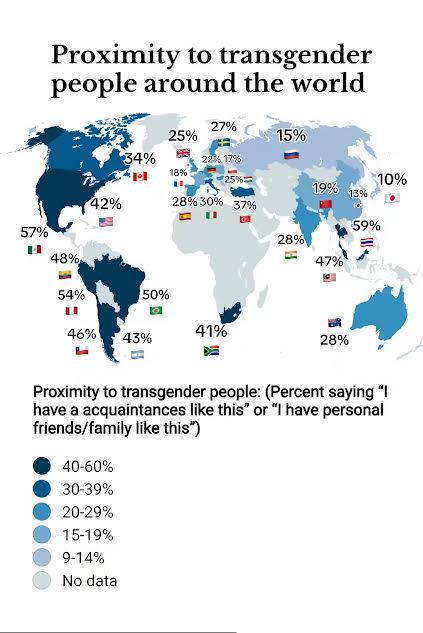Map of Proximity to Transgender People Worldwide


Alex Cartwright
Senior Cartographer & GIS Specialist
Alex Cartwright is a renowned cartographer and geographic information systems specialist with over 15 years of experience in spatial analysis and data...
Geographic Analysis
What This Map Shows
The "Proximity to Transgender People Around the World" map, based on the IPSOS 2018 poll, visually represents the levels of acceptance and visibility of transgender individuals across various countries. This map provides insights into how different cultures and societies perceive and interact with transgender communities. It categorizes regions based on reported proximity to transgender people, reflecting both societal attitudes and legal frameworks that affect the lives of transgender individuals globally.
However, this map doesn’t just illustrate distances; it speaks volumes about the social fabric of nations, highlighting areas where acceptance is more prevalent and where significant challenges remain.
Deep Dive into Transgender Rights and Visibility
The topic of transgender rights and visibility has gained increasing attention in recent years. Transgender individuals often face unique challenges, including discrimination, violence, and a lack of access to healthcare services. The visibility of transgender people in society can significantly influence public perception and acceptance. In places where transgender individuals are more visible—either through media representation or community activism—there tends to be a higher level of acceptance and support.
According to the IPSOS 2018 poll data, countries like Canada and Sweden report a higher proximity to transgender people, reflecting progressive attitudes and supportive legislation. For instance, Canada has implemented various legal protections for transgender individuals, including the right to self-identify their gender and access healthcare tailored to their needs. Interestingly, Sweden's commitment to gender equality extends to transgender rights, fostering an environment where transgender individuals can live openly and authentically.
On the other hand, regions such as parts of Eastern Europe and many countries in Africa often showcase a much lower proximity to transgender individuals. In these areas, societal norms can be rigid, and individuals may face severe repercussions for expressing their gender identity. For example, in countries like Uganda and Nigeria, laws criminalizing LGBTQ+ identities contribute to a hostile environment where transgender individuals often live in fear.
The map serves as a reminder that the experience of being transgender is not uniform; it varies significantly depending on geographic, cultural, and legal contexts. Understanding these nuances is essential, as they affect everything from mental health outcomes to social integration for transgender individuals.
Regional Analysis
Examining the map in more detail offers a fascinating glimpse into how different regions approach transgender issues. In North America, for instance, not only is there a relatively high proximity to transgender people, but there are also numerous advocacy groups working towards enhancing rights and visibility. The Human Rights Campaign and GLAAD are just two organizations that actively engage in policy advocacy and community support.
Comparatively, in Latin America, countries like Argentina stand out for their progressive transgender laws, including the Gender Identity Law, which allows individuals to change their gender on official documents without the need for surgery. This progressive stance contributes to a relatively higher proximity to transgender individuals, particularly in urban areas like Buenos Aires, where pride parades and awareness campaigns are prevalent.
In contrast, Asia presents a mixed picture. Nations such as Thailand have a visible transgender community known as “kathoey,” yet societal acceptance can still be inconsistent. Meanwhile, in parts of the Middle East, many countries have laws that severely punish homosexuality and gender nonconformity, leading to a much lower presence and visibility of transgender individuals. The contrast between regions illustrates how cultural context influences the experiences of transgender people.
Significance and Impact
Understanding the proximity to transgender people is crucial for several reasons. First, it highlights the disparities in acceptance and rights that exist globally, reminding us that the fight for equality is far from over. Have you noticed how societal attitudes can shift over time? With increasing visibility and advocacy, many countries are beginning to reconsider their stances on gender identity, leading to potential policy changes and societal acceptance.
Moreover, this topic connects deeply with human rights issues. Transgender individuals often experience higher rates of mental health challenges, largely due to discrimination and social ostracism. Mapping the proximity to transgender people allows us to identify where support systems may be lacking and where advocacy efforts should be focused.
Looking ahead, the ongoing dialogue surrounding transgender rights suggests that we may see shifts in these geographic patterns. As more countries recognize the importance of inclusivity and human rights, we could witness an increase in the visibility and acceptance of transgender individuals, leading to a more equitable world for everyone.
In summary, the map of proximity to transgender people is more than just a visual tool; it serves as a critical lens through which we can examine societal attitudes and the ongoing struggle for acceptance and rights for transgender individuals worldwide.
Visualization Details
- Published
- September 8, 2025
- Views
- 80
Comments
Loading comments...